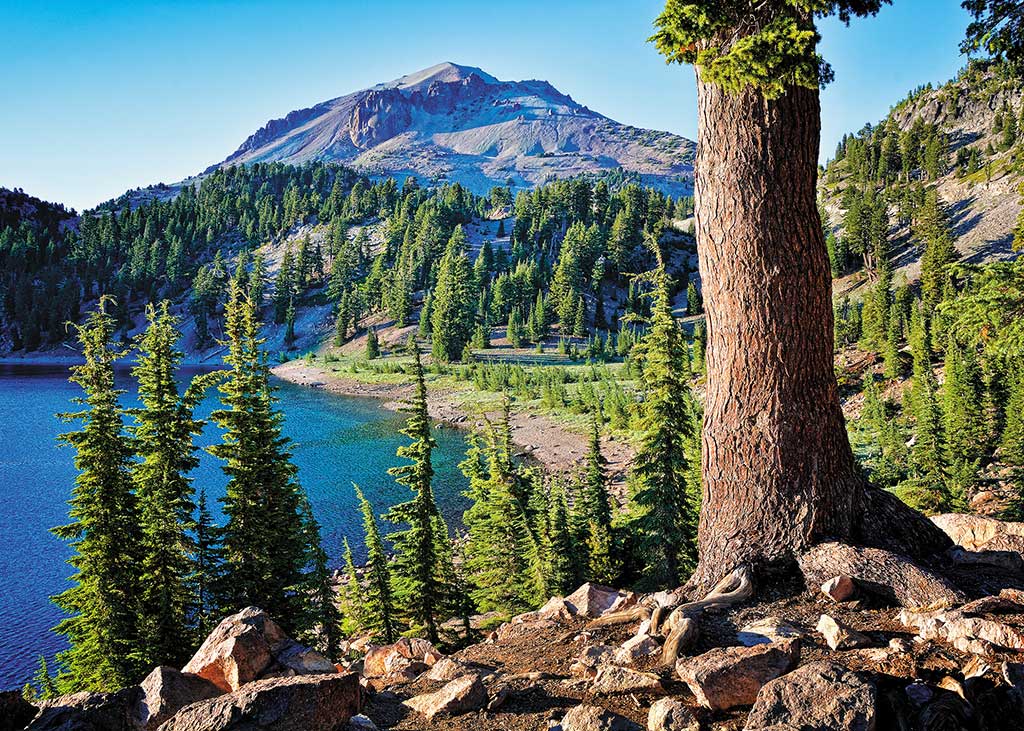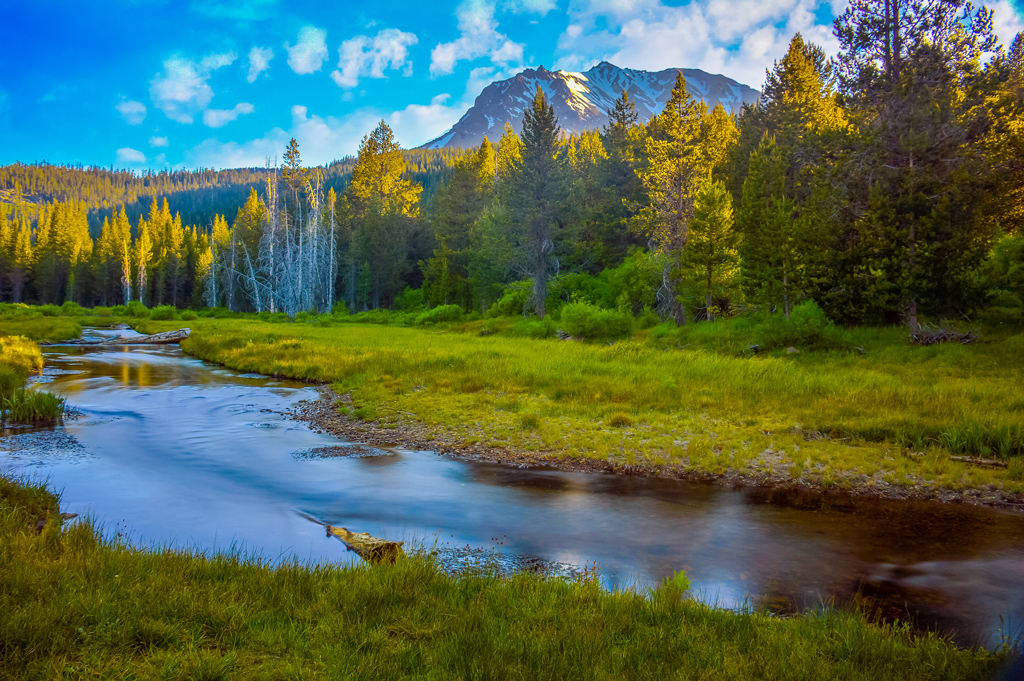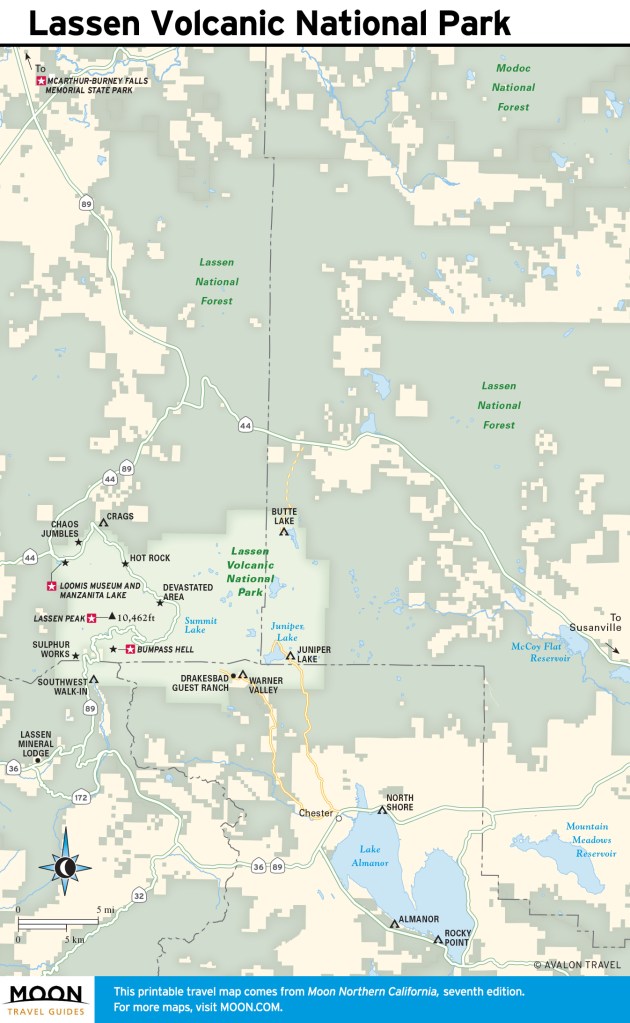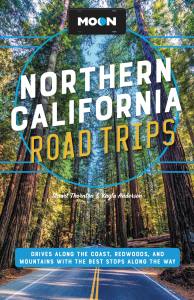Plan a Visit to Lassen Volcanic National Park
Lassen Volcanic National Park resulted from the merger of two National Monuments—Cinder Cone and Lassen Peak—in 1916. As such, it is one of the oldest national parks in the United States; it is also one of the remotest and most primitive.

A paved road runs through the middle of the park, making it easy in summer for visitors to enjoy many of the major attractions—including the park’s active volcanic features. The rugged weather and isolated location mean that a visit to Lassen Volcanic National Park is a trip to a largely unspoiled wilderness rather than an overdeveloped amusement park with rocks. A good half of the park has only minimal dirt-road access and offers its rugged beauty only to those travelers willing to hike for miles into the backcountry. Even the trails and campgrounds accessible by the paved main road maintain a kind of charm that’s hard to find in the more popular California parks.
Mount Lassen itself is an active volcano with a long recorded history of eruptions, the last of which took place in 1914-1917. The mountain is a beautiful sight, and it’s only accessible to most people during the short summer months when the temperatures rise and the snow melts.
Sights
Lassen Volcanic National Park has ample hiking trails, lovely little ponds scattered throughout, and many campsites that let visitors settle in and really enjoy the amazing panoramas of Mount Lassen. A wonderful loop drive through the park takes you from the stark slopes and jagged rocks of the most recent eruption around the back to an enormous ancient crater, the remains of a long-gone volcano as big as or bigger than Mount Shasta. Beyond the bounds of the national park, national forest lands allow for additional exploration.
Although it is officially open year-round, snow chokes the area from as early as October until as late as June, closing the main road through the park and making even the lower-altitude campground snowy and cold. The only time to visit Lassen is the height of summer; most visitors pick August and early September. Call 530/595-4480 for updates on road conditions before planning a trip.
Newsletter Signup
By clicking ‘Sign Up,’ I acknowledge that I have read and agree to Hachette Book Group’s Privacy Policy and Terms of Use
Kohm Yah-mah-nee Visitors Center
Lassen’s first permanent year-round visitors center, Kohm Yah-mah-nee Visitors Center (530/595-4480, 9am-5pm daily Apr.-Oct., 9am-5pm daily Wed.-Sun. Nov.-Mar.) opened in 2008, which was 92 years after the park was created. The name Kohm Yah-mah-nee is from the language of the local Maidu people and means “snow mountain,” which was their name for Lassen Peak.
Awarded the highest level of Leadership in Energy and Environmental Design (LEED) certification, this modern, comfortable, state-of-the-art facility was worth the wait. It’s got an auditorium showing new films about the park, interactive exhibits illuminating local geology and ecology, an unusually well-stocked snack bar and grill, a souvenir-and-sundries shop, an attractive amphitheater, a first-aid center, and large modern restrooms. Outside, strategically placed benches make great spots to enjoy lunch or a snack while you take a load off and enjoy gorgeous views of the mountains. One of the best features for a group with mixed ages and abilities is the very short interpretive trails just outside, with paved walkways and informative signage.
Located near the southwest entrance to the park on Highway 89, the visitors center is open every day except Thanksgiving and Christmas, and it’s accessible even when other roads in the park are closed because of snow (which is common). It’s convenient to the Sulphur Works and to the trailheads for Brokeoff Mountain and Ridge Lakes.
Lassen Peak
It’s not as tall as it used to be, but Lassen Peak still reaches 10,457 feet into the sky. Even if you’re not up to climbing it, it’s worth stopping at the parking lot at the trailhead to crane your neck and enjoy the view. The craggy broken mountain peak is what’s left after the most recent eruption—hence the lack of vegetation. The starting elevation for the summit trail is 8,000 feet, which means the Lassen Peak trailhead tends to be cool even in the heat of summer. You may need to break out a windbreaker or light sweater if you plan to explore at length. The Lassen Peak Trail (5 miles, difficult) leads to the highest point on Mount Lassen.

Loomis Museum and Manzanita Lake
As you enter the northwestern edge of the park on Highway 89, almost immediately you’ll find Loomis Museum (530/595-6140, 9am-5pm Fri.-Sun. mid-May-mid-June, 9am-5pm daily mid-June-Oct., free) and Manzanita Lake. Inside the museum is a wonderful opportunity to learn about the known history of Mount Lassen, focusing heavily on the 1914-1915 eruptions photographed by Mr. B. F. Loomis. Prints of those rare and stunning photos have been enlarged and captioned to create these exhibits; the museum was named for the photographer, who later became a major player in the push to make Mount Lassen a national park. This interpretive museum offers a rare chance to see, through photos, the devastation and following stages of regrowth of the ecosystem on the volcanic slopes.
Bumpass Hell
The best and most varied area of volcanic geothermal activity on Lassen is at a location called Bumpass Hell (6 miles from the southwest entrance). The region was named for Kendall Vanhook Bumpass, who, during his explorations, stepped through a thin crust over a boiling mud pot and severely burned his leg, ultimately losing the limb. In fact, the tale of the unfortunate Bumpass illustrates a good point for travelers visiting the mud pots and fumaroles: Stay on the paths! The dangers at Bumpass Hell are real, and if you step off the boardwalks or let your children run wild, you are risking serious injury.
Still, a hike down to Bumpass Hell on the Bumpass Nature Trail is fun. As long as you’re careful, it’s worth the risk. You’ll need to walk about two miles from the parking lot and trailhead out to the interesting stuff—boiling mud pots, fumaroles, steaming springs, and pools of steaming boiling water cluster here. Prepare for the strong smell of sulfur, more evidence that this volcano is anything but extinct. Boardwalks are strategically placed through the area, creating safe walking paths for visitors.
The spacious parking lot at Bumpass offers stunning views to the east and south, giving you a hint at the scope of the ancient volcano that once stood here. Right at the parking lot you can see a famous “glacial erratic,” a boulder carried along by a glacier; this one is about 10 feet high, demonstrating the colossal forces of nature that have been at work in this park over the millennia. There are also primitive toilet facilities in the parking lot.

Newsletter Signup
By clicking ‘Sign Up,’ I acknowledge that I have read and agree to Hachette Book Group’s Privacy Policy and Terms of Use
Pin For Later



